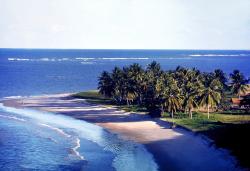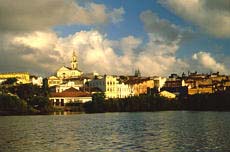Advertising by Google
João Pessoa, Paraíba
Area: 210 km²
Population: 649.910 inhab. (est. 2004).
See map of Paraíba.
The name of the city is a tribute to João Pessoa Cavalcanti de Albuquerque, a politician born in the State of Paraíba. João Pessoa was murdered when he was in campaign for the vice-Presidency of Brazil, in 1930 (read more about Getulio Vargas, who was the candidate for Presidency); that same year, the name of the city was changed.
João Pessoa is the second ranking city in the world in terms of green spaces, with more than 700 hectares of forested land, losing only to Paris. It gained this distinction in 1992, after a survey of urban centres in several countries carried out by the United Nations.
With its parks and avenues lined with fruit bearing and ornamental trees, João Pessoa also preserves parts of the Atlantic forest in the central area of the city, such as in the Parque da Bica and in the Mata do Buraquinho; these two reserves are important centers for study of tropical fauna and flora, and have an important role in keeping the temperature of the city .
 One of the most ancient cities on Brazil, João Pessoa was founded in 1585 at the mouth of the Paraíba river; the Portuguese chose this strategic position to build the Fortress São Felipe (a tribute to King Felipe, from Portugal); the first name of the city was Filipéia. The fortress succeeded in defending the area from French attacks, but could not resist the Dutch, who invaded and occupied a good part of Northeast of Brazil (including the neighbour cities of Recife and Natal) from 1634 to 1654.
One of the most ancient cities on Brazil, João Pessoa was founded in 1585 at the mouth of the Paraíba river; the Portuguese chose this strategic position to build the Fortress São Felipe (a tribute to King Felipe, from Portugal); the first name of the city was Filipéia. The fortress succeeded in defending the area from French attacks, but could not resist the Dutch, who invaded and occupied a good part of Northeast of Brazil (including the neighbour cities of Recife and Natal) from 1634 to 1654.
One of the oldest cities in Brazil, its Historic Centre includes churches, palaces, houses and other buildings from the colonial and imperial past. There is the Casa de Pólvora, a former powder warehouse turned into a museum today; the Convent of Santo Antonio and the church of São Francisco, forming the "baroque area", construction of which commenced in 1589 and took almost 200 years to complete (the baroque area of Joao Pessoa was subject of a book; click here to read more); and the Monastery, considered important for the beauty of its facade, which includes sculptures, decorated tiles and wood carvings, reflecting the influence of indigenous art.
João Pessoa is a coastal city, and most of its beaches are in its outlying districts. Among them are Tambaú, 7 kilometres from the city centre, comprising one of the most famous postcard views with the beauty of the scene and the jangadas on the sea;
 Penha, only two kilometres away, a small fishing village; and, a little further out at 48 kilometres, Tambaba, the only beach in the North East of Brazil devoted entirely to naturalism. See some photos of João Pessoa beaches.
Penha, only two kilometres away, a small fishing village; and, a little further out at 48 kilometres, Tambaba, the only beach in the North East of Brazil devoted entirely to naturalism. See some photos of João Pessoa beaches.
South of João Pessoa, 14 kilometres from the centre, is the easternmost point in the Americas, Ponta do Seixas; nearby is Cabo Branco, a popular beach for the beauty of its 50 metre high cliffs and the lighthouse of the same name.
Near João Pessoa, there are good places for boat strolls, as the natural pools of Picãozinho and on the island Areia Vermelha. Many operators offer also buggy tours along the beaches of the State.
The sunset on the beach Jacaré (about 10 km north of João Pessoa) became a famous attraction, after major Brazilian TV programs exhibited reports on it. It´s a line up of six small restaurants, all overlooking the sea; everyday, near sunset, a sax player on a boat performs Bolero, by Ravel, for delight of eyes and ears.
Read more:
 Official site. Maintained by the city government.
Official site. Maintained by the city government.
 João Pessoa. Comprehensive travel guide, in Portuguese.
João Pessoa. Comprehensive travel guide, in Portuguese.
 João Pessoa. Information in English.
João Pessoa. Information in English.
 João Pessoa in German. Information in German about João Pessoa. Includes photos.
João Pessoa in German. Information in German about João Pessoa. Includes photos.
 Tour tips. By a Brazilian travel magazine, in Portuguese only. Includes several photos.
Tour tips. By a Brazilian travel magazine, in Portuguese only. Includes several photos.
 Photos of João Pessoa. With comments, in English.
Photos of João Pessoa. With comments, in English.
 Universidade Federal da Paraíba. The Federal University of Paraíba, campus in João Pessoa.
Universidade Federal da Paraíba. The Federal University of Paraíba, campus in João Pessoa.
Back to Top